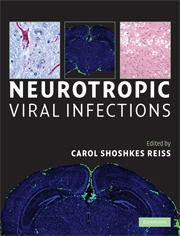Book contents
- Frontmatter
- Contents
- List of contributors
- Foreword
- Preface and acknowledgments
- Section I Introduction: RNA viruses
- Section II Introduction: retroviruses, DNA viruses, and prions
- 8 Human T-lymphotropic virus type 1 and disease in the central nervous system
- 9 HIV infection of the central nervous system
- 10 JC virus molecular biology and the human demyelinating disease, progressive multifocal leukoencephalopathy
- 11 The herpes simplex viruses
- 12 The pathogenesis of varicella-zoster virus neurotropism and infection
- 13 Transmissible spongiform encephalopathies
- Section III Introduction: immunity, diagnosis, vector, and beneficial uses of neurotropic viruses
- Index
- Plate section
- References
12 - The pathogenesis of varicella-zoster virus neurotropism and infection
from Section II - Introduction: retroviruses, DNA viruses, and prions
Published online by Cambridge University Press: 22 August 2009
- Frontmatter
- Contents
- List of contributors
- Foreword
- Preface and acknowledgments
- Section I Introduction: RNA viruses
- Section II Introduction: retroviruses, DNA viruses, and prions
- 8 Human T-lymphotropic virus type 1 and disease in the central nervous system
- 9 HIV infection of the central nervous system
- 10 JC virus molecular biology and the human demyelinating disease, progressive multifocal leukoencephalopathy
- 11 The herpes simplex viruses
- 12 The pathogenesis of varicella-zoster virus neurotropism and infection
- 13 Transmissible spongiform encephalopathies
- Section III Introduction: immunity, diagnosis, vector, and beneficial uses of neurotropic viruses
- Index
- Plate section
- References
Summary
Introduction
Varicella-zoster virus (VZV) is a neurotropic human herpesvirus that causes varicella, which is commonly known as chicken pox, as the primary infection in susceptible individuals. In the healthy host, varicella is usually a mild, self-limiting febrile illness characterized by a generalized, pruritic vesicular rash (Figure 12.1A). Like other alphaherpesviruses, VZV gains access to sensory ganglia of the peripheral nervous system during primary infection and establishes lifelong persistence at these sites. VZV reactivation from latency causes herpes zoster, called “shingles,” and is associated with a vesicular rash localized to one of the cutaneous dermatomes of the face, trunk, or extremities (Figure 12.1B). The dermatomal rash reflects the region of skin innervated by the cranial nerve or dorsal root ganglion where reactivation is occurring. VZV is highly contagious and is maintained in the human population by close contact with individuals who have varicella or herpes zoster. Both primary and recurrent VZV infections are more severe in immunocompromised patients because resolution requires an effective cell-mediated immune response. Antiviral drugs that inhibit VZV replication are effective in most high-risk patients with varicella or herpes zoster. VZV is the only human herpesvirus for which vaccines that prevent or modify the severity of primary and recurrent infections have been developed. These vaccines are made from the VZV/Oka strain, attenuated by passage in vitro.
While the clinical manifestations of varicella and herpes zoster are well-documented, knowledge about the mechanisms of VZV pathogenesis in the human host is limited because primary and recurrent infections are rarely fatal and VZV infection is highly species-specific for the human host.
- Type
- Chapter
- Information
- Neurotropic Viral Infections , pp. 225 - 250Publisher: Cambridge University PressPrint publication year: 2008
References
- 8
- Cited by



